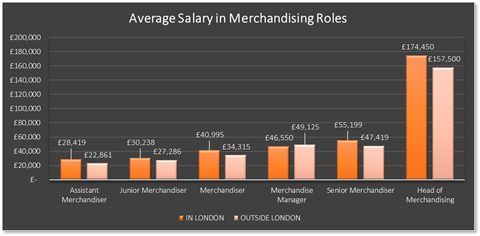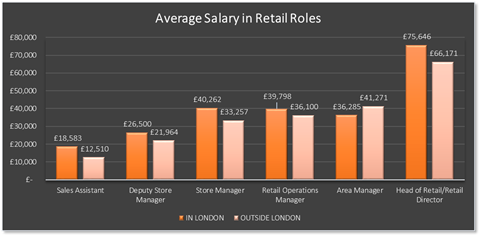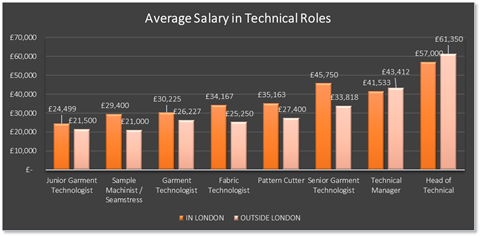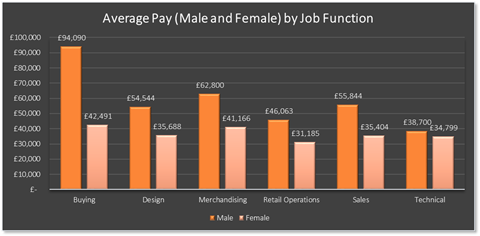The retail industry is only ever as good as the people it employs. Attracting and retaining the very best has never been more important for fashion retailers, as they fight to stay one step ahead of both the competition and the customer. Not only this, but fresh talent is constantly needed to fill roles that did not exist even five years ago, in growing fields such as social media, data, technology and ecommerce.
Retailers are also facing a tougher time attracting international candidates, as a result of uncertainty caused by Britain’s decision to leave the European Union. Talented creative workers could be put off coming to the work in the UK fashion industry if travel restrictions and visa costs are imposed, the Creative Industries Federation has warned, reducing the flow of people to what is usually a flexible and progressive industry.
The Drapers salary survey investigates pay levels in key functions across the fashion industry, from merchandising to retail operations and technical skills. The research reveals the average salary across different roles, with variations by geography, along with what you can expect to earn at the very top of your chosen field.
Many of the job functions covered in this report have undergone dramatic shifts in required skills, as the industry continues to be transformed by new technologies. Drapers also spoke to leaders in their field to find out how they have seen their roles change and which skills and abilities are at the top of their wish lists.
Competitive salaries are one of the most obvious ways the fashion industry can attract the brightest and best, particularly when battling for candidates against typically well-paid sectors such as finance and technology. However, what is also clear is that a high salary does not guarantee job satisfaction.
Concerns over pay do emerge as one reason why respondents to Drapers’ survey chose to leave their last role, but it was not the biggest driver behind a career move – just 14% said salary was the reason they had last decided to change businesses. In comparison, 31% said the move was prompted by a lack of career progression. To retain their best employees, retailers must be able to demonstrate clear next steps in their career paths and outline what they need to achieve to climb to the next rung of the ladder.
Fashion is a fast-paced, ambitious industry and its people are constantly on the lookout for new opportunities. Nearly half of survey respondents (48%) said they would consider moving to a new role, again reiterating the need to value good people. This group said they were open to new opportunities, compared with 27% who said they were not looking and 25% who are actively seeking a new role.
Here is our breakdown of the key statistics in each job function.
The Drapers Salary Survey was conducted by 3Gem on 11-14 October 2017 and produced in association with Michael Page
MERCHANDISING
Average salary: £44,000
A good merchandiser has always needed a head for numbers, but the role is now increasingly data driven, as technology delivers more information about the customer journey than ever before. Greater frequency of product drops, coupled with shoppers who want to buy now to wear tonight, makes getting the right stock into the right store a delicate balancing act.
“You need great attention to detail – a key part of the job is spotting opportunities and trends in the figures, as well as keeping a close eye on the budget,” explains Tara Singleton, head of merchandising for kidswear at Marks & Spencer.

“Merchandisers are involved at every stage of the buying cycle, from building and budgeting the range to placing orders and ensuring the product arrives in store at the right time and in the right quantities. An analytical mind and strong commercial instinct will get you a long way. And because you are liaising with so many different areas of the business, great communication skills are important.”
Drapers’ research revealed the average salary in merchandising (as with buying) is £44,000. However, the largest proportion of survey respondents (34%) fell into the £20,000-£34,999 salary band. Slightly under a quarter (24%) said their salary was between £35,000 and £49,999, and only a small proportion (6%) took home a salary in the maximum bracket of £100,000 or more.
The research also showed that working in London influences how much merchandisers earn, no matter where they are on the career ladder. A junior merchandiser earns £27,000, on average, if they work outside of London, compared with £30,000 for those based in the capital.
This trend continues even at merchandising director level, where the average salary in the rest of the country hits £158,000 but jumps to £174,000 in London. Salaries at the top of merchandising were the highest of all sectors covered in the survey.
“Marks & Spencer has a great reputation as an employer, so we get a lot of strong candidates for merchandising positions,” adds Singleton. “We welcome a range of skills and experience because it makes a stronger and more creative team. However, when people think of a career in fashion, they often think of design first. There is definitely more that can be done to show young people how rewarding and diverse a career in merchandising can be.”
What it’s like in merchandising: Tom Saliba, merchandise manager at Missguided

Tom Saliba began his career at Asos in 2008, moved to River Island in 2011 and to Topshop in 2014. He spent three years there, overseeing Topshop’s brands and Beyoncé’s athleisure line, Ivy Park ,as a senior merchandiser. He has recently moved to Missguided, one of the UK’s fastest growing fashion retailers.
“It’s exciting to think that even though they’ve achieved so much already, and the reality is that they’re only just getting started,” he tells Drapers.
Saliba chose the merchandise function because “it seems to cater quite nicely for someone with an analytical brain, but who also has a keen interest in fashion and retail.”
His biggest lesson so far, he adds, is that “people are absolutely and undoubtedly a company’s greatest asset.”
His advice for anyone interested in getting into merchandising is: “Hard work will never go unnoticed and politeness doesn’t cost a penny.”
BUYING
Average salary: £44,000
Buying is perceived as one of retail’s more-glamorous roles, making competition in this popular field very fierce.
“Buying is a still a highly sought-after area of the industry for fashion professionals; it is very attractive for creative people who thrive on a fast pace,” explains Caroline Gilbey, associate dean of Ravensbourne’s fashion department.

However, this is also a rapidly changing field, in which a wide range of skills is necessary for success. Buyers must balance creativity with efficiency and mathematical savvy.
“An understanding of margins is crucial,” adds Gilbey. “Digital innovation has changed the role and buyers have more information than ever on which to base decisions. They now have access to global trends at the click of a finger. This is critical, as, increasingly, they are having to buy for global markets as brands spread internationally. They also have to work faster as seasons become shorter.”
Those looking to take their first steps in a buying career can expect to earn £21,000, on average, as an assistant buyer outside of London and £23,000 for those based in London. A healthy bump in salary rewards those who make the cut and progress to the next level. Drapers’ research shows the average salary for junior buyers reaches £34,000 for those working in London and £30,000 in the rest of the country. Buyers who rise to the very top of their field and secure a coveted role as head of buying or buying director are in line to earn £124,000 outside of London and £128,000 in the capital.
Almost half (41%) of buying respondents fell into the £20,000–£34,999 salary bracket, followed by 23% earning £35,000–£49,999 and almost a fifth (19%) on £50,000–£74,999. This is also a field that is dominated by women. Almost 90% of survey respondents who worked in buying were female, compared with 69% of merchandisers and 61% of those working in retail operations.
An eye for product and gut instinct for the next bestseller are important qualities in buying – but so too is having an analytical approach, a good grip of numbers and the understanding that this is unlikely to be a “9 to 5” job.
What it’s like in buying: Jordan Coventry, junior buyer at Topman

Jordan Coventry started at F&F on their graduate scheme. He worked across various departments before being promoted to assistant buyer, a role he held for two years. From there, he moved to Topman.
Coventry found the buying department appealing because it requires a “unique mix of creative and business skills.”
He adds: “Buying departments get to work with the design teams to develop amazing product, and with suppliers to deliver that product to customers - you see the whole process and there’s a great sense of achievement seeing your range in stores.”
His advice for those looking to progress in buying is to keep learning. “There are so many experts involved in retail. When I first started I was in awe of those that seemed to have endless knowledge - and still am. Make the most of it - more often than not people are eager to share what they know when you show your enthusiasm.”
RETAIL OPERATIONS
Average salary: £37,000
Retail operations covers a wide range of different roles, from store managers to operation managers and heads of retail. As a result, salaries in this field can vary dramatically.
Salaries for those working in store have traditionally lagged behind the rest of the industry: starting salaries for sales assistants are relatively low and could act as a barrier to talented candidates who might otherwise choose to work their way up with a view to becoming a store or area manager. Sales assistants earn an average salary of £19,000 in London and just £12,000 in the rest of the country, perhaps reflecting the perception that this is not seen as a long-term career option for many.
“Many larger retailers have restructured their store teams to save money, often meaning that more is being asked of other staff for little or no more additional reward,” warns Juliet Paul, head of retail operations at recruitment firm Michael Page.

Those who do make the move to store management positions see a healthy increase in their salaries. For deputy managers, the average salary in London hits £27,000 and £22,000 elsewhere. There is another big jump to store manager level, when salaries in London rise significantly to £40,000, and to £33,000 in the rest of the country.
The other side of the retail operations coin is head office operations – an increasingly complex role that covers everything from global supply chains and IT systems to delivery and expanding overseas. Over the past year alone, those working in this field have had to contend with the implications of the vote for Brexit along with currency fluctuations.
At £40,000, salaries for retail operations managers in London are the same as store managers based in the capital. Those elsewhere in the country earn £36,000.
There is another considerable leap in salary at retail director and head of retail level, where salaries hit £76,000 in London and £66,000 in the rest of the country.
What it’s like in opertations: Marjolein Wind, senior retail operations co-ordinator at Arcadia Group

Marjolein Wind started her retail career at Accessorize as a sales adviser.
“Through a good relationship with the franchise owner, I got an opportunity to work at the head office in London on their international operations team.” From there, she moved to BHS as a new business co-ordinator, then to Arcadia Group’s international department, establishing its retail operations function.
Wind says she enjoys the diverse workload involved with retail operations: “If you want a career in retail operations, you need to be open to change and be part of the change. The retail world is ever changing and within operations it’s all about thinking of the next solution, implementing new or improved processes, and driving trade through best practice.”
TECHNICAL
Average salary: £36,000
Once at risk of vanishing, UK manufacturing has had something of a resurgence as the rising costs of overseas production, coupled with the need for flexible supply chains, reignites interest in domestic sourcing and manufacturing. New Look and Asos are among those expressing an interest in producing more in the UK, and specialist skills are already in hot demand.
“Getting people with good technical skills, like garment technologists and pattern cutters, can be like finding hens’ teeth,” explains Jade Holland Cooper, founder of luxury lifestyle label Holland Cooper, which manufactures in the UK.

Pattern cutting is one area that Holland Cooper highlights as having a particularly large number of opportunities. Salaries in pattern cutting are similar to those for a designer or buyer – a London-based pattern cutter can expect to earn £35,000, while the average salary for the same role sits at £27,000 outside of the capital.
Almost half (48%) of survey respondents working in technical roles fell in the £20,000-£34,999 salary bracket, followed by a quarter earning £35,000-£49,000 and 20% earning £50,000-£74,999. Those starting out as a junior garment technologist can expect to earn £24,000 if they work in London. Salaries rise to £30,000 for London-based garment technologists and £26,000 for those working elsewhere in the country. Wages for sample machinists and seamstresses are broadly similar, at an average salary of £27,000.
Although there are well-paid opportunities in technical roles, salaries at the top of this field are lower than in other areas. A technical manager can expect to earn £43,000 in London, while salaries for the same role in the rest of the country sitting close behind at £42,000. The average salary for a head of technical across the whole country is £59,000.
DESIGN
Average salary: £38,000
Design is another extremely popular sector of the fashion industry – one in which success requires balancing a number of different skills, as well as combining creativity and commercial know-how.
“A combined skillset is becoming more and more popular [among retailers],” explains Elizabeth Bevan, a senior consultant in design and development at Michael Page. “Gone are the days when a designer can sit behind a desk and sketch. Businesses are seeking big personalities, who can work with buyers to drive the business forward.
“Having recruited for everything from assistant design through to creative director, attitude remains the most important skillset that every client looks for. In such a competitive industry, you will always have to keep proving yourself to your employer, but those with the right attitude are very much in charge of their progression.”

When getting a foot in the door, an assistant designer can expect to earn £22,000 both in and outside of London. Although the average salary in design is lower than in buying and merchandising, overall pay prospects are good. By the time those assistant designers have risen through the ranks to become a fully fledged designers, the average salary in London hits £31,000 and £29,000 in the rest of the country.
When designers get to a senior level, where in the country they choose to work makes a real difference to their salaries. A senior designer employed in London earns an average salary of £50,000 – significantly more than those outside of the capital who earn £38,000. Although this evens out slightly once they become a head of design or creative director (£77,000 in London, £70,000 elsewhere), there is still a considerable gap to be bridged between London and the rest of the country.
The type of business in which a designer works also makes a difference to their earnings: a London-based designer working with a supplier earns £36,000, compared with £43,000 for those working for a retailer.
What it’s like in design: Catherine Lovell, senior womenswear designer at N Brown

After graduation, Catherine Lovell got a design assistant role with a high street supplier.
“It was full on from the beginning but from there I pushed for promotions and absorbed everything I learnt along the way.” This included everything from finding the newest fabrics, to trends and sourcing, to learning the best way to sell a design and get an idea off the ground.
Lovell advises those starting out to take a proactive approach: “If you have an idea, shout about it, and don’t be afraid to ask questions – it’s the best way to learn.” She adds that it is important to be confident about networking with managers and directors, because this is the best way to get your name out there.
SALES
Average £43,000
This is a traditionally lucrative part of the retail industry, in which salaries are high – even lower down the career ladder. A London-based sales manager earns an average of £37,000 and those elsewhere in the country can expect to receive £31,000. The average head of sales earns £57,000 in London and £48,000 outside the capital.
“What we look for [in sales roles] is someone with a bit of experience, as well as a maths brain,” explains Claire Spencer Churchill, co-owner of London-based fashion agency Claret Showroom. “As much as the buying side of the business is more about data, the selling side is too, so easily navigating Excel is fairly important.”

She adds that sales, like most of the other fields in the fashion industry, has undergone big shifts over the past couple of years: “There has been a real change in how buyers buy and, therefore, how we sell. Brands are producing so many more collections, and there has been a move towards ‘see now, buy now’.
“You need to be charismatic and approachable with a really personal touch, so buyers get a good first impression. We are also finding that there is much less hand-holding – buyers have done their research and know what they want.”
Just under a third (32%) of sales respondents fell into the £20,000-£34,999 salary bracket, 28% received £35,000-£49,999 and 18% earned £50,000-£74,999. Just 3% were in the £75,000-£99,999 category, and 6% were in the top salary bracket of £100,000 or more.
Just over half (55%) of survey respondents working in sales said they did not receive an end-of-year bonus. Of those who did, 15% took home either 0%-5% or 6%-10% of their annual salary, 10% received 11%-20%, and 3% received 31%-40%. Just 1% took home a monster bonus of 41%-50% or more than 51% of their annual salary.
What it’s like in sales: Mauro Santa Barbara, regional sales manager at Belstaff

Mauro Santa Barbara started working on the shop floor at Leeds menswear independent Accent Clothing in 2006.
“I had a deep love for product from my teenage years and was spending most of my student loan in there, so I figured that getting a weekend job at the store would help me cover some of my spending and get me staff discount,” Santa Barbara recalls.
He quickly caught the bug for serving customers and selling product – particularly Belstaff outerwear: “I became fascinated with the stories behind the brands and used that knowledge to convert sales.”
Despite an interest in moving into buying, Santa Barbara found himself drawn back to sales roles – at Dutch young fashion label Scotch & Soda and British heritage biker brand Matchless – before coming full circle and taking a role as regional sales manager at Belstaff.
His love of product has driven his career throughout, he says, and this passion is crucial: “Money isn’t everything. Make sure you love and believe in what you do. This is a very demanding line of work. To excel, you have got to consistently be on top of your game, developing ideas and applying yourself. It all becomes very difficult if you don’t have the passion for the brand and product you are working with.”
His advice? Start on the shop floor, and make sure you are always learning.
GENDER PAY GAP
Britain’s gender pay gap closed to the lowest level since records began this year, Office for National Statistics data shows. However, there is still a 9.1% disparity between the average earnings of male and female workers across the country.
In 2018, employers with 250 staff or more must publish and report figures on their gender pay gap by April. Smaller businesses could also be forced to disclose the gap between what male and female workers are paid. In October, prime minister Theresa May argued that more companies should be required to publish data, as well as urging business to help women progress through the ranks.
Steps are being taken to address the gender pay gap across all industries but Drapers’ research shows that, in retail at least, more still needs to be done. The average salary across all female respondents to the survey was £37,000 – dramatically less than the £59,000 average salary for men. Just 2% of women fell in the top salary bracket of £100,000 or more, compared with 11% of men.
This trend continued into the next highest salary band of £75,000-£99,999 – 3% of women are in this category, compared with 9% of men. In contrast, 47% of women and 24% of men said they earned £20,000-£34,999 and almost a one-tenth (9%) of women earned £10,000-£19,999, compared with just 3% of men. More than half (54%) of female respondents said they did not receive an end-of-year bonus; for men, this figure sat at 39%.
It is clear from Drapers’ survey that women are still outnumbered in the top jobs. A study on gender diversity at 44 retailers across a range of sectors, including fashion, published last year by consultancy Elixirr and Women in Retail found that although 60% of employees were women, only 20% of boardroom executives were female.
The new gender pay gap reporting should help shine a light on issues surrounding pay, forcing retailers to answer for any salary disparity between the amounts male and female employees earn. However, there is still a long way to go before retail executive boards accurately reflect their workforces.

PARTNER COMMENT
I am delighted that Michael Page has had the opportunity to partner with Drapers on this exciting project. Our Fashion team has specialised in recruiting across buying, merchandising, design, technology, sales, marketing, HR, digital and operational roles for over 20 years so it seems right that we’d be the natural choice to support on this market wide salary survey that has been published for everyone associated with the Fashion sector.
We are currently going through the most transformative period for fashion retail in decades, technological advances mean shopper behaviour has changed like never before and those retailers not embracing innovation are sadly falling away. It is for this reason the timing of this salary survey was so pertinent.
The arms race for top talent across all areas of the fashion industry is fierce and in some areas such as digital we are seeing unjustifiable salary increases being expected as standard. Equally we have still not been able to address the shortage of quality merchandising talent, yet those who are prepared to look at a new challenge are expected to do so with minimal financial movement – there is huge discrepancy. We also have the highly charged topical subject of the gender pay gap, of which I will be a profoundly interested observer once this report is published.
I hope you find the report useful and enjoy the findings.

Dave Mann
Dave Mann - Director, Retail & Fashion, Michael Page
